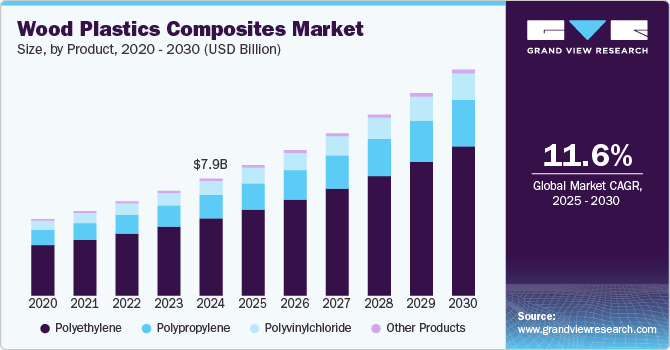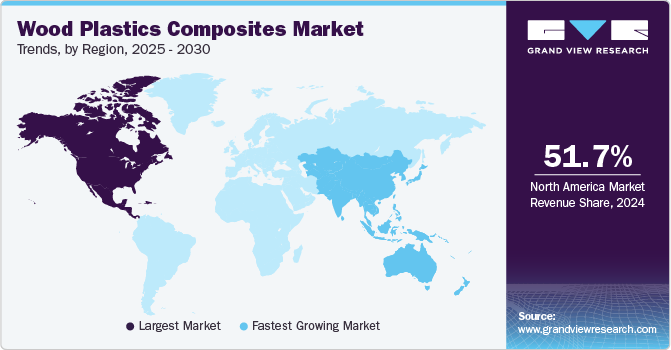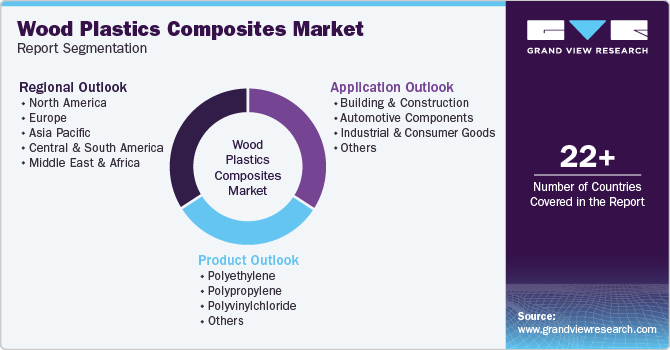
Wood Plastics Composites Market Size, Share & Trends Analysis Report By Product (Polyethylene, Polypropylene), By Application (Automotive Components), By Region, And Segment Forecasts, 2025 - 2030
- Report ID: 978-1-68038-849-7
- Number of Report Pages: 198
- Format: PDF, Horizon Databook
- Historical Range: 2018 - 2023
- Forecast Period: 2025 - 2030
- Industry: Advanced Materials
Wood Plastics Composites Market Trends
The global wood plastics composites market size was estimated at USD 7.97 billion in 2024 and is projected to grow at a CAGR of 11.6% from 2025 to 2030. The market is driven by the rising demand for sustainable construction materials along with an increase in renovation and repair activities in the residential sector across the globe.

Wood plastic composites are increasingly being used in construction applications. Wood plastic composites are being employed in roofing applications as well as in the manufacturing of glass windows. In developing countries, wood plastic composites are replacing standard wood in roofing applications on account of its high strength. This is on account of its tendency to break into larger pieces as compared to standard wood, which prevents sharp shards upon breakage, which can lead to serious human injuries in case of an accident.
Furthermore, wood plastic composite has a lower melting temperature as compared to conventional wood products, which lowers the energy cost for end-users and also reduces the environmental impact of the product. Wood plastic composite can be worked upon by the same tools utilized for wood products. This factor eliminates the investments to be made by the manufacturers and the risks associated with recouping the same.
Biggest tech companies such as IBM, Microsoft, and Cisco are investing in megaprojects to build smart, sustainable cities across the globe. Investments in these cities are expected to reach USD 135.00 trillion in the next two years. In addition to these cities, international megaprojects such as Hudson Yards and Masdar City have created opportunities for interior construction manufacturers resulting in surging wood plastic composite demand over the coming years.
Wood flour is hygroscopic in nature and must be wetted properly with the use of a thermoplastic matrix; otherwise, it can absorb moisture, which leads to weak mechanical properties, unwanted odors, and microbial attacks. The technique requires complex machine arrangements and skilled laborers resulting in increasing the overall cost of the products. This, in turn can restrict the market growth over the projected years.
The market growth stage is medium, with an accelerating pace of growth. The major key players in the market are using their in-house technology and manufacturing processes for wood plastic composite products. In addition, various software is used by the key players to build a 3D model for residential and commercial building & construction projects, leading to a moderate degree of innovation.
The industry participants are implementing strategies, including mergers and acquisitions, to strengthen their foothold in the market. For instance, In May 2022, UFP Industries, Inc. announced the acquisition of Cedar Poly LLC for USD 17.0 million. This helped UFP Industries, Inc. vertically integrate the sourcing of recycled polymers and increase the use of post-industrial waste materials in their products without compromising the quality of the overall products.
Regulations and standards moderately impact the wood plastic composites industry by ensuring product quality, safety, and environmental sustainability. Standards related to mechanical properties, durability, and performance help maintain consistency and reliability in wood plastic composite products, boosting consumer confidence and market acceptance.
The product is prone to staining and color fading due to the presence of wood particles. In addition, the presence of mineral-based composite products and pure plastic-based products acts as an alternative to the WPC products. However, WPC products exhibit the lowest price point; thereby, the level of substitution threat is expected to be moderate over the forecast period.
Product Insights
The polyethylene product segment led the market and accounted for a 65.9% share of global revenue in 2024. The high demand for polyethylene in manufacturing furniture for homes, offices, restaurants, resorts and hospitals. Moreover, the rising demand for polyethylene in the automotive industry, owing to its low cost, high stiffness, and biodegradability, is expected to further propel the market growth over the coming years. Low cost, high stiffness, abundant raw material availability, and biodegradability offered by polyethylene-based wood plastic composite products are likely to open new avenues for market growth.
In terms of revenue, polypropylene is the fastest-growing product segment and is anticipated to grow at a CAGR of 11.9% from 2024 to 2030. This higher share is attributed to its heavy use in niche application segments such as water-resistant coatings on furniture and high-temperature controllable wooden units.
Polyvinylchloride is projected to register a CAGR of 11.4% in terms of volume over the forecast period. Growing demand for polyvinylchloride thermoplastics in automotive applications for manufacturing door panels, seat cushions, cabin linings, backrests, and dashboards on account of its excellent insulation properties is expected to have a positive impact on the market growth over the forecast period. Polyvinylchloride thermoplastics have insulation properties and are thus employed in the manufacturing of insulative products for applications in the electrical and automotive industries.
The rising demand for polystyrene and acrylonitrile butadiene styrene composites in a wide range of applications such as kitchen furniture, shower receptors, bathtubs, windowsills, and whirlpool baths on account of its high durability and environment-friendly characteristics is expected to boost market growth over the next eight years.
Application Insights
The building and construction segment led the market and accounted for 71.3% of the global revenue share in 2024. Increasing infrastructural development activities in emerging economies such as China, India, Thailand, and Brazil, coupled with the growing demand for aesthetically appealing furniture and flooring solutions across the globe, has surged the demand for wood plastic composite in the construction industry. Rising demand for various plastic-based wood products in construction applications, especially for decking, is expected to propel market growth.
The use of recyclable or biodegradable wood-plastic composite-based parts in automobiles is expected to improve mechanical strength and acoustic performance. In addition, it also reduces material weight and fuel consumption, reduces manufacturing costs, and improves passenger safety and shatterproof performance. These factors are forecasted to boost the segment at an anticipated fastest CAGR of 12.4% from 2025 to 2030.

Wood filled PVC is gaining popularity because of its balance of thermal stability, moisture resistance, stiffness, and strength, although being more expensive than unfilled PVC. Wood-plastic composites are used in a variety of sectors across the world, although their methodologies differ. For longevity, they extrude wood-filled PVC with an unfilled PVC cap stock, while others extrude a PVC core with a paintable wood filled PVC surface.
Increasing demand for wood plastic composite in manufacturing noise barriers for street construction, sheet pilings for landscaping, and garden furniture is expected to surge the product demand over the forecast period. In addition, the rising demand for wood plastic composite in manufacturing consumer goods, including toys and showpieces, is anticipated to further propel the market growth over the coming years.
Regional Insights
The North America wood plastics composites market in accounted for the largest revenue market share of 51.7% in 2024. Automotive and construction industries in North America are showing growth signs. Moreover, the reduction in unemployment rates, passage of major infrastructure-related bills, and reduced prices due to shale gas flooding the market are some of the key reasons for the growth of the construction industry in the region, further supporting the product demand in the region.

U.S. Wood Plastics Composites Market Trends
The U.S. wood plastics composite market dominated in North America in terms of production as well as demand. The demand is expected to grow over the forecast period owing to the rising application scope of the product in manufacturing docks, porches, and window frames.
In terms of revenue, the wood plastics composite market in Canada is expected to progress at an estimated CAGR of 11.2% over the forecast period. Increasing utilization from consumer goods and niche product segments coupled with rising demand from building & construction, thereby boosting product demand.
Europe Wood Plastics Composites Market Trends
Europe wood plastics composites marketwas valued at USD 1.12 billion in 2024. The growth of the automotive industry in the region, which uses the product to manufacture interior & exterior trims, is anticipated to propel the demand for the product over the forecast period. However, the region has reached the stage of maturity and, thereby expected to grow at a sluggish rate over the forecast period.
The demand for Germany wood plastics composites market accounted for a revenue of USD 247.9 million in 2024. Rising electric vehicle adoption in Germany is expected to raise demand for WPC products, including trims and additional shelves is expected to drive the market growth on a positive note.
Asia Pacific Wood Plastics Composites Market Trends
Asia-Pacific wood plastics composite market is expected to progress at the fastest CAGR of 12.4% over the forecast period. Increasing population in countries including India, China, Bangladesh, and Pakistan coupled with changing consumer lifestyles, has resulted in the growth of the construction and consumer goods industry in the region, which in turn is expected to have a positive impact on the market growth over the forecast period.
India wood plastics market is expected to witness significant growth on account of the rising expansion of the capital market, the presence of small- & large-scale industries, and rising foreign exchange reserves. Government’s ‘Make in India’ initiative is further expected to boost the consumer goods application segment. Hence, Wood plastic composites market revenue in India is growing at a CAGR of 13.0% over the forecast period of 2025 to 2030.
Central & South America Wood Plastics Composites Market Trends
Central and South America wood plastics market is driven by construction activities in the Central and South American economies that have grown substantially owing to the rising income levels and shifting consumer preference towards green buildings. The expanding commercial construction sector, coupled with the government initiatives to create awareness about green buildings among people is expected to stimulate the Central and South America market growth over the forecast period.
Key Wood Plastics Composites Company Insights
Some of the key players operating in the market include CertainTeed, LLC., JELU-WERK J. Ehrler GmbH & Co. KG, RENOLIT SE, Trex Company, Inc., and Oakio Plastic Wood Building Materials Co. Ltd.:
-
CertainTeed, LLC. has segregated its business into two divisions which include exterior building, and interior building. The product portfolio under exterior building products includes roofing, siding, trim, sheathing, fence, decking and railing, foundations, windows, and fiber cement siding. Moreover, the company has a wide geographical presence and offers its products in over 100 countries.
-
JELU-WERK J. Ehrler GmbH & Co. KG is engaged in the production of wood plastic composite compounds, lignocellulose, and cellulose using plant fibers. The wood plastic composite brands of the company operating in the market are Jelucel, Jeluvet, and Jeluxyl. The company distributes its products across all five major regions across the globe.
Beologic, Fiberon, FKuR, Guangzhou Kindwood Co. Ltd., and UFP Industries, Inc. are some of the emerging market participants in the market.
-
UFP Industries, Inc. is engaged in the manufacturing and distribution of wood and wood-based alternative products. The company has three reportable segments including retail, construction, and industrial. The company has over 170 facilities in over 100 countries, including the U.S., Canada, Mexico, India, Japan, UK, and Australia which supplies tens of thousands of products to its three-business segment.
-
Fiberon manufactures and distributes wood plastic composite products, which include composite decking, railings, and cladding. Its North Carolina production facility includes 400,000 square feet of manufacturing space and 175,000 square feet of assembly and warehouse space.
Key Wood Plastics Composites Companies:
The following are the leading companies in the wood plastics composites market. These companies collectively hold the largest market share and dictate industry trends.
- CertainTeed, LLC.
- Beologic
- Fiberon
- FKuR
- Guangzhou Kindwood Co. Ltd.
- JELU-WERK J. Ehrler GmbH & Co. KG
- PolyPlank AB
- RENOLIT SE
- TAMKO Building Products LLC
- The AZEK Company Inc. (TimberTech)
- Trex Company, Inc.
- UFP Industries, Inc.
- Hardy Smith Designs Private Limited.
- Oakio Plastic Wood Building Materials Co. Ltd.
View a comprehensive list of companies in the Wood Plastics Composites Market
Recent Developments
-
In June 2024, Oakio Plastic Wood Building Materials Co. Ltd., Inc. introduced Proshield WPC Cladding. This advanced cladding solution offers durability, sustainability, and aesthetic versatility for exterior building materials. Proshield WPC Cladding is engineered with a unique blend of wood fibers and high-density polyethylene encased in a robust polymer shield.
-
In January 2023, UFP Industries, Inc. announced to feature new and innovative products from two leading brands, Deckorators and UFP-Edge. These distinctive products allow both DIYers and builders to bring the personal creativity of interior design to outdoor living, thereby helping the company to gain a competitive edge.
Wood Plastics Composites Market Report Scope
|
Report Attribute |
Details |
|
Market size value in 2025 |
USD 8.89 billion |
|
Revenue forecast in 2030 |
USD 15.41 billion |
|
Growth rate |
CAGR of 11.6% from 2025 to 2030 |
|
Base year for estimation |
2024 |
|
Historical data |
2018 - 2023 |
|
Forecast period |
2025 - 2030 |
|
Quantitative units |
Volume in kilotons, revenue in USD million/billion, and CAGR from 2025 to 2030 |
|
Report coverage |
Revenue forecast, company ranking, competitive landscape, growth factors, and trends |
|
Segments covered |
Product, application, region |
|
Regional scope |
North America, Europe, Asia Pacific, Central & South America, Middle East & Africa |
|
Country scope |
U.S., Mexico, Canada, UK, Germany, France, Spain, Italy, Russia, Netherlands, Switzerland, China, Japan, India, South Korea, Australia, Indonesia, Thailand, Singapore, New Zealand, Philippines, Brazil, Argentina, Chile, Saudi Arabia, South Africa, UAE, Egypt, Iran |
|
Key companies profiled |
CertainTeed, LLC., Beologic, Fiberon, FKuR, Guangzhou Kindwood Co. Ltd. JELU-WERK J. Ehrler GmbH & Co. KG, PolyPlank AB, RENOLIT SE, TAMKO Building Products LLC, The AZEK Company Inc. (TimberTech), Trex Company, Inc., UFP Industries, Inc., Hardy Smith Designs Private Limited., Oakio Plastic Wood Building Materials Co. Ltd. |
|
Customization scope |
Free report customization (equivalent up to 8 analysts’ working days) with purchase. Addition or alteration to country, regional & segment scope. |
|
Pricing and purchase options |
Avail customized purchase options to meet your exact research needs. Explore purchase options |
Global Wood Plastic Composites Market Report Segmentation
This report forecasts revenue growth at global, regional, and country levels and provides an analysis of the latest industry trends in each of the sub-segments from 2018 to 2030. For this study, Grand View Research has segmented the global wood plastic composites market report based on product, application, and region:

-
Product Outlook (Volume, Kilotons; Revenue, USD Million, 2018 - 2030)
-
Polyethylene
-
Polypropylene
-
Polyvinylchloride
-
Others
-
-
Application Outlook (Volume, Kilotons; Revenue, USD Million, 2018 - 2030)
-
Building And Construction
-
Automotive Components
-
Industrial And Consumer Goods
-
Others
-
-
Regional Outlook (Volume, Kilotons; Revenue, USD Million, 2018 - 2030)
-
North America
-
U.S.
-
Canada
-
Mexico
-
-
Europe
-
Germany
-
U.K.
-
France
-
Spain
-
Italy
-
Russia
-
Netherlands
-
Switzerland
-
-
Asia Pacific
-
China
-
India
-
Japan
-
Australia
-
South Korea
-
Thailand
-
Indonesia
-
Singapore
-
New Zealand
-
Philippines
-
-
Central & South America
-
Brazil
-
Argentina
-
Chile
-
-
Middle East
-
Saudi Arabia
-
South Africa
-
United Arab Emirates (UAE)
-
Egypt
-
Iran
-
-
Frequently Asked Questions About This Report
b. The global wood plastic composites market size was estimated at USD 7.97 billion in 2024 and is expected to reach USD 8.89 billion in 2025.
b. The global wood plastic composites market is expected to grow at a compound annual growth rate of 11.6% from 2025 to 2030 to reach USD 15.41 billion by 2030.
b. Polyethylene product segment dominated the market and accounted for more than 65.9% share of the global revenue in 2024. The market is driven by the rising demand for sustainable construction materials along with an increase in renovation and repair activities in the residential sector across the globe.
b. Some of the key players operating in the wood plastic composites market include CertainTeed, LLC., Beologic, Fiberon, FKuR, Guangzhou Kindwood Co. Ltd. JELU-WERK J. Ehrler GmbH & Co. KG, PolyPlank AB, RENOLIT SE, TAMKO Building Products LLC, and Trex Company, Inc., UFP Industries, Inc.
b. The key factors driving the wood plastic composites market include increasing product use in several residential, industrial, and commercial sectors. Moreover, increasing consumer preferences for green buildings are projected to boost the demand for wood plastic composites in the construction industry over the coming years.
We are committed towards customer satisfaction, and quality service.
"The quality of research they have done for us has been excellent."




